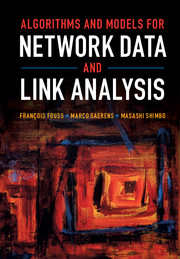Book contents
- Frontmatter
- Contents
- List of Algorithms
- List of Symbols and Notation
- Preface
- 1 Preliminaries and Notation
- 2 Similarity/Proximity Measures between Nodes
- 3 Families of Dissimilarity between Nodes
- 4 Centrality Measures on Nodes and Edges
- 5 Identifying Prestigious Nodes
- 6 Labeling Nodes: Within-Network Classification
- 7 Clustering Nodes
- 8 Finding Dense Regions
- 9 Bipartite Graph Analysis
- 10 Graph Embedding
- Bibliography
- Index
- References
Bibliography
Published online by Cambridge University Press: 05 July 2016
- Frontmatter
- Contents
- List of Algorithms
- List of Symbols and Notation
- Preface
- 1 Preliminaries and Notation
- 2 Similarity/Proximity Measures between Nodes
- 3 Families of Dissimilarity between Nodes
- 4 Centrality Measures on Nodes and Edges
- 5 Identifying Prestigious Nodes
- 6 Labeling Nodes: Within-Network Classification
- 7 Clustering Nodes
- 8 Finding Dense Regions
- 9 Bipartite Graph Analysis
- 10 Graph Embedding
- Bibliography
- Index
- References
- Type
- Chapter
- Information
- Algorithms and Models for Network Data and Link Analysis , pp. 479 - 514Publisher: Cambridge University PressPrint publication year: 2016



